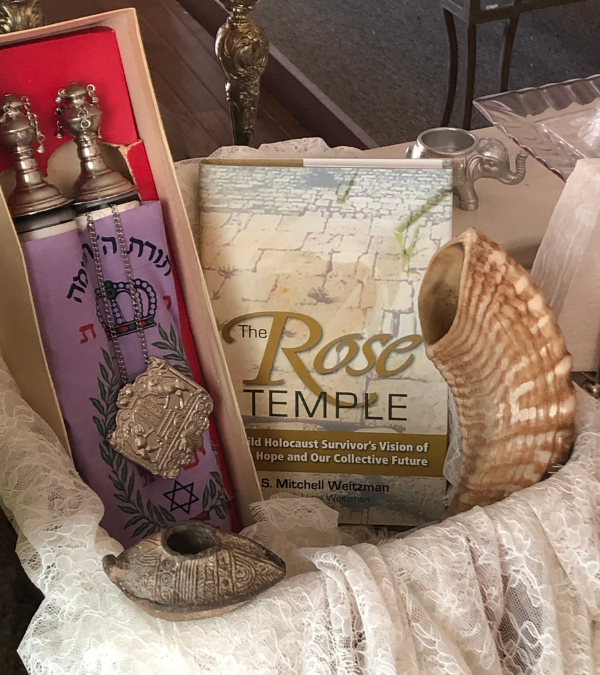“I want to manage expectations,” I told my mother prior to her visiting our home to observe Rosh Hashanah, the Jewish New Year, in late September 2022. She hoped that my son, Joshua, would have enough strength to blow the Shofar, a ritual ram’s horn, that she’d once gifted him. But Joshua, 21, could hardly walk up a flight of stairs. His faced was flushed with low-grade fever. Even talking was difficult at times.
For a year, Joshua’s health, already compromised by autoimmune challenges, had progressively gotten worse following illness during the COVID pandemic. It would turn out be a convergence of conditions now known under various names, including Long COVID, or myalgic encephalomyelitis/chronic fatigue syndrome. An aspiring music producer who’d been accepted to NYU’s prestigious music program, he’s been forced to take medical leave. In a religious season full of hope and promise, our family was mired in concern and despair.
I prepared for a brief service at home to minimize Joshua’s exertion. I set out handouts of healing prayers and created our own “ark”— a miniature Torah my late father had once owned; a Second-Third Century clay oil lamp my mother had acquired from an archeologist in Jerusalem; a copy of the book my mother and I had written, The Rose Temple; and the Shofar.
At the point in the service that calls for blowing of the Shofar, I gently handed Joshua the instrument.
A Shofar is blown somewhat like a trumpet. Referenced several times in the Bible, it is, among other things, a call that reminds us of our connection to the Divine.
Traditionally, there are four shofar sounds, with meanings ascribed to each. Tekiah, a blast lasting 2-3 seconds, is said to coronate God as creator of the world and to awaken us from spiritual slumber. Shevraim—three medium length blasts—
can be understood as being derived from the Hebrew word shever, which means fracture; and, consequently, is a plea for hope and healing. Teruah, nine short staccato sounds, is said to be a call for action to realize our potential, even if progress is measured in small steps. The fourth Shofar sound, the Tekiah Gedolah is a booming, sustained finale, enrapturing us in the spiritual awe of the moment.
Blowing a Shofar is not as easy as blowing a horn. Even experienced Shofar blowers can require multiple attempts before achieving the right sound. Joshua had not practiced. He had no energy for that. I held my breath as he pressed the Shofar mouthpiece against his lips and created a seal. I braced for the inevitable disappointment and frustration that would follow.
I called out the sounds, a conductor facing a tentative orchestra:
Tekiah.
Shevarim.
Teruah.
Joshua played them flawlessly. Effortlessly.
The Tekiah Gedolah was next. I was certain that there was nothing left in his tank. We’d call it a victory and move on.
“Tekiah Gedolah,” I called out uneasily.
What came next was a sustained, powerful, improbable, mystical blast that had once accompanied the revelation at Mount Sinai; and that had once brought down the walls at Jericho in the presence of … Joshua.
My mother, wife, and I glanced at each other in awe. Our eyes welled with tears.
It was clear that a heavenly force had taken hold of the Shofar and worked its way through Joshua’s being. We were instantly aware of what could only be described as a Biblical-like miracle that had just occurred.
Physicians, diagnostic tools, lab tests, and medicines all have an important place in healing and wellness. I cannot, however, imagine anything that could have explained the force of Joshua’s Shofar blowing transcending our physical world into the heavens.
There have been, and there will undoubtedly continue to be, challenges ahead. Like so many suffering through illness, misfortune, and tragedy, Joshua
struggles to cope with the weight of the circumstances he involuntarily finds himself in.
But on one day in September 2022, Joshua, my wife, and my mother witnessed a force that was more powerful than any illness: The power of the Divine. The power of hope.


You are all an inspiration for all to admire. The challenges, the emotions and the resilience to find solutions and joy amidst the difficulties of living life are truly inspirational to me.
Thank you for sharing this with us. There is much we all can find in your and Joshua’s strength to help us be better for knowing your story and that is part of the Blessing you have given us.
Yasher Koach and may this year fill your heart with love, peace and joy. And may Joshua find his way in this life to be strong, loving and find success in all he endeavors to do.